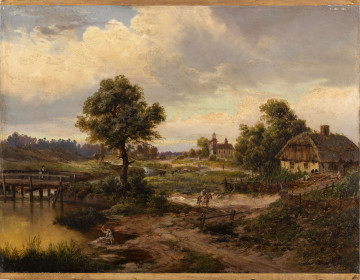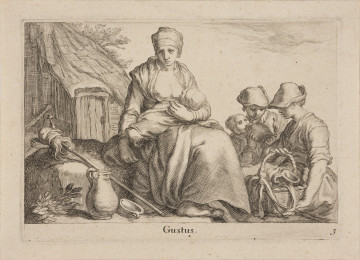
Landscape with a small church
1897
National Museum in Lublin
Part of the collection: Polish landscape painting (19th–1st half of the 20th c.)
As a painter and master of a generation of artists, Jan Stanislawski played probably the most crucial role in forming the Polish school of landscape painting in the first decade of the 20th century. One of the critics of that time called him a great painter of small pictures, and these words accurately reflect the character of his work. Convinced that the world of nature hides the secret of life, Stanisławski devoted all his art to discovering and preserving its fragments. He painted nature landscapes exclusively on tiny formats, often no larger than a sheet of paper. He captured the places he visited during his numerous journeys. The best paintings show views from Ukraine and Malopolska. Stanisławski did not focus on faithful reproduction of details; meticulous, ‘scientific’ realism was alien to him. Instead, he tried to render on his canvases what was most challenging to capture – fleeting impressions, fleeting sensations and emotions. They can be treated as the artist's confession, speaking of his admiration for the beauty and perfection of the surrounding world, which manifests itself in its most ordinary and most minor phenomena. That is why prosaic motifs and seemingly insignificant objects, such as a wheat field, an orchard beehive, a solitary tree, or the ruddy stems of crab apple or mullein, are so often the heroes of tiny masterpieces.
Similar banal motifs can be seen in Pejzaż [Landscape]. The ‘trimmed’ fragment chosen by the painter shows an ordinary rural landscape in late summer, namely, a vast field covered with weeds, a few cottages on the horizon, the sky. However, in Stanisławski's artistic vision, it turns into a miracle of sensual contemplation of nature. Thanks to the sunlight, so skilfully rendered that the painting seems to be filled with natural air that shimmers with heat, the earth, trees, flowering plants, and simple cottages acquire a poetic and symbolic dimension in its silver-gold radiance. Landscape, and more broadly, the whole oeuvre of Stanisławski, is a hymn of praise to nature and its Creator, affirmed in every glimpse. The painter admired and acknowledged the perfection of the divine work, manifesting itself to him in the tiniest, yet most important, elements. The paintings of this ‘aristocrat of the landscape’ can be treated as spiritual testament by which each of us receives a part of immeasurable wealth of the world's beauty.
Bożena Kasperowicz
Author / creator
Dimensions
cały obiekt: height: 28,5 cm, width: 20,5 cm
Object type
painting
Technique
oil technique
Material
canvas, oil-based paint
Creation time / dating
Creation / finding place
Owner
The National Museum in Lublin
Identification number
Location / status

1897
National Museum in Lublin

between 1632 — 1670
National Museum in Szczecin
1911
National Museum in Lublin
DISCOVER this TOPIC
National Museum in Szczecin
DISCOVER this PATH
Educational path